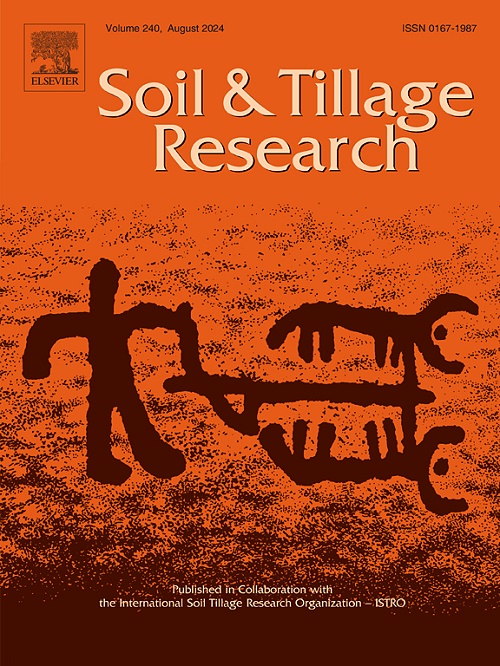Impacts of a fully mechanized timber harvesting system on soil physical properties after a pronounced dry period
IF 6.1
1区 农林科学
Q1 SOIL SCIENCE
引用次数: 0
Abstract
Within the wood supply chain, timber harvesting plays a crucial role, especially with the growing importance of bioeconomy. This study focused on the effects of a fully mechanized timber harvesting system using a harvester and forwarder on various soil properties in a mixed stand dominated by Picea abies located in Upper Austria. Using portable wheel load scales, we measured the load per wheel of both the empty and loaded forwarder. We analyzed soil rutting and penetration resistance before and after two harvester passes, after two and nine forwarder passes, and at the end of the harvesting operations (npasses = 18). Soil samples were collected using steel cylinders before and after the harvester, and at the end of the harvesting operation. We measured soil water content, bulk density, total porosity, and the C/N ratio. The results showed a mean rut depth of 13 cm after the harvesting operation was completed. Soil deformation began in predisposed areas (e.g., roots and stumps). Maximum penetration resistance occurred at 10–15 cm, highlighting the substantial impact of both harvester and forwarder at this depth. Harvester effects on penetration resistance were noticeable down to 40 cm, while forwarder effects extended beyond 80 cm. Significant changes in bulk density appeared only after forwarder passes. Low initial water content (12 Vol.–%) enhances soil stability, reducing impacts compared to winter harvesting under the high–moisture conditions. Harvesting at the end of a dry period (e.g., late summer) is a viable alternative for protecting soil physical properties.
全机械化木材采伐系统对明显干旱期后土壤物理特性的影响
在木材供应链中,木材采伐起着至关重要的作用,特别是随着生物经济的日益重要。本研究的重点是在上奥地利以云杉为主的混交林中,采用收割机和转运机的全机械化木材采伐系统对各种土壤特性的影响。使用便携式轮式载重秤,我们测量了空载货代和载货货代每轮的载重。我们分析了两次收获机通过前后、两次和九次转运机通过后以及收获作业结束时(npasses = 18)土壤车痕和穿透阻力。在收割机前后和收割机操作结束时,用钢瓶收集土壤样品。我们测量了土壤含水量、容重、总孔隙度和碳氮比。结果表明,采收完成后,平均车辙深度为13 cm。土壤变形开始于易受影响的区域(如树根和树桩)。最大穿透阻力发生在10-15 厘米处,突出了收割机和转运机在该深度的重大影响。收割机对穿透阻力的影响可明显降低至40 cm,而传送带的影响则超过80 cm。只有在货代通过后,堆积密度才会出现显著变化。较低的初始含水量(12 Vol. - %)提高了土壤稳定性,与高湿度条件下的冬季收获相比,减少了影响。在干旱期结束时(如夏末)收获是保护土壤物理特性的可行选择。
本文章由计算机程序翻译,如有差异,请以英文原文为准。
求助全文
约1分钟内获得全文
求助全文
来源期刊

Soil & Tillage Research
农林科学-土壤科学
CiteScore
13.00
自引率
6.20%
发文量
266
审稿时长
5 months
期刊介绍:
Soil & Tillage Research examines the physical, chemical and biological changes in the soil caused by tillage and field traffic. Manuscripts will be considered on aspects of soil science, physics, technology, mechanization and applied engineering for a sustainable balance among productivity, environmental quality and profitability. The following are examples of suitable topics within the scope of the journal of Soil and Tillage Research:
The agricultural and biosystems engineering associated with tillage (including no-tillage, reduced-tillage and direct drilling), irrigation and drainage, crops and crop rotations, fertilization, rehabilitation of mine spoils and processes used to modify soils. Soil change effects on establishment and yield of crops, growth of plants and roots, structure and erosion of soil, cycling of carbon and nutrients, greenhouse gas emissions, leaching, runoff and other processes that affect environmental quality. Characterization or modeling of tillage and field traffic responses, soil, climate, or topographic effects, soil deformation processes, tillage tools, traction devices, energy requirements, economics, surface and subsurface water quality effects, tillage effects on weed, pest and disease control, and their interactions.
 求助内容:
求助内容: 应助结果提醒方式:
应助结果提醒方式:


